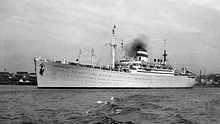SS Albert Ballin
This article includes a list of references, related reading, or external links, but its sources remain unclear because it lacks inline citations. (July 2009) |
 SS Albert Ballin pulling in to port on September 27th 1923
| |
| History | |
|---|---|
| Name | Albert Ballin |
| Namesake | Albert Ballin |
| Owner | Hamburg-America Line |
| Builder | Blohm & Voss, Hamburg |
| Launched | 16 December 1922 |
| Maiden voyage | 5 July 1923 |
| Fate | Requisitioned by the Kriegsmarine, 1940 |
| Name | Hansa |
| Operator | Hamburg-America Line |
| In service | 31 October 1935 |
| Fate | Sunk 6 March 1945, Warnemünde |
| Name | Sovetskiy Soyuz (translate as "Soviet Union") |
| Acquired | By salvage, 1949 |
| In service | 1953–1982 |
| Renamed | 1980, Tobolsk |
| Fate | Scrapped, 1982 |
| General characteristics (1923) | |
| Type | Ocean liner |
| Tonnage | 20,815 GRT |
| Length | 183.61m |
| Beam | 22.18m |
| Speed | 16 knots |
| Capacity | 1650 passengers |
| Notes | Sister ship Deustchland |
SS Albert Ballin was an ocean liner of the Hamburg-America Line launched in 1923 and named after Albert Ballin, the visionary director of the Hamburg-America line, who had committed suicide several years earlier. In 1935, the ship was renamed Hansa on orders from the German government. Towards the end of World War II, she was employed to evacuate civilians during Operation Hannibal, and sank after hitting a mine. She was later raised and refitted by the Soviet Union and was finally scrapped in 1982.
History
[edit]


Hamburg America Line
[edit]Albert Ballin was built by Blohm & Voss in Hamburg, and served on the Hamburg-New York City route. In 1928, a tourist class was added. Originally built as a 16 knot ship, the engines were replaced in 1929, resulting in a speed of 19 knots. In 1934, she was lengthened by 50 feet, and speed increased again, this time to 21.5 knots.
In 1935, the new Nazi government ordered the ship be renamed Hansa (Ballin having been Jewish). Hansa's last Atlantic crossing was in 1939.
In 1945, she was employed to evacuate civilians from Gotenhafen during Operation Hannibal, and was due to accompany the overloaded MV Wilhelm Gustloff leaving midday on 30 January, but suffered mechanical problems before the ships had left the Bay of Danzig and had to anchor. Later, on 6 March during a further evacuation, she hit a mine off Warnemünde and slowly sank.
Soviet Union
[edit]The wreck was raised and rebuilt by the Soviet Union around 1949, and renamed Sovetskiy Soyuz (Russian: Советский Союз; meaning Soviet Union), becoming the largest passenger ship operating under the Soviet flag. From 1955, she operated between Vladivostok and points in the Far East. Renamed Tobolsk (Russian: Тобольск[1]) in 1980, she sailed under that name for almost two years before being scrapped.
See also
[edit]References
[edit]- ^ "Тобольск". FleetPhoto.ru. 2010.
- Bonsor, N.R.P. (1975), North Atlantic seaway : an illustrated history of the passenger services linking the Old World with the New in four volumes, New York: Arco, ISBN 978-0-7153-6401-7, OCLC 1891992
- Haws, Duncan (1980), The ships of the Hamburg America, Adler and Carr lines, Merchant fleets in profile, vol. 4, Cambridge: Stephens, OCLC 60073185
- Swiggum, S.; Kohli, M., TheShipsList, retrieved 2013-01-18
External links
[edit]
